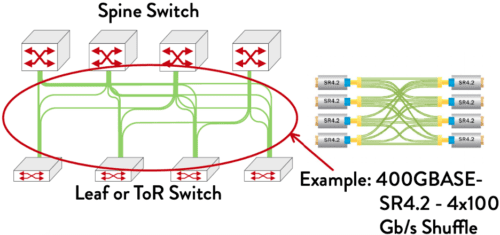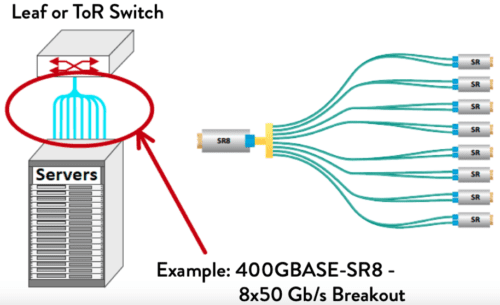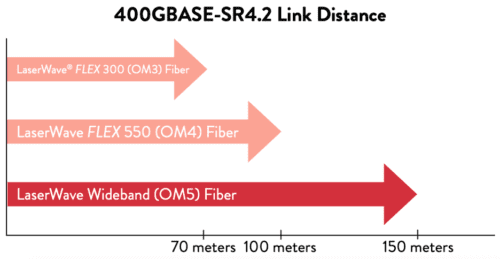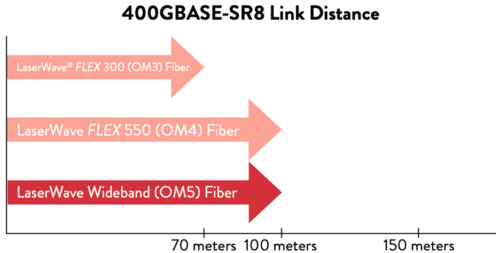What is IEEE Std 802.3cm-2020, 400 Gb/s over Multimode Fiber?
The work of the IEEE Std P802.3cm Task Force was approved as a new standard by the IEEE-SA Standards Board on 30 January 2020, creating the latest 400 Gb/s Ethernet standard using multimode fiber. 400 Gb/s is the highest Ethernet speed, and 400 Gb/s optical modules are needed in hyperscale (Google, Microsoft, Alibaba, and others) and very large-scale enterprise datacenters. 802.3cm defines 400 Gb/s solutions over both 4-pair (400GBASE-SR4.2) and 8-pair (400GBASE-SR8) multimode links. The IEEE P802.3cm Task Force was chaired by Robert Lingle, Jr., Senior Director of Market Strategy at OFS.
400GBASE-SR4.2 is the first multimode standard to use two wavelengths (850nm and 910nm), enabling 100 Gb/s transmission over a single fiber pair. It takes advantage of the multi-wavelength capabilities of OFS LaserWave® WideBand (OM5) fiber with 150 meter link distances, while supporting 100 meter links over LaserWave FLEX 550 (OM4) fiber and 70 meter links over LaserWave FLEX 300 (OM3) fiber. This builds on well-established 40 and 100G BiDi and SWDM technology that has been offered by switch and transceiver suppliers over the past decade. A key motivation for the 400GBASE-SR4.2 transceiver type is support of the installed base of multimode fiber cabling, designed around 100 meter reach over OM4 MMF, as well as extended reach over OM5 MMF, especially in large enterprise datacenters. 400GBASE-SR8 uses eight pairs of multimode fiber, with each pair supporting 50 Gb/s transmission. It operates over a single wavelength (850nm). OM4 and OM5 will support 100 meter links, while OM3 can support up to 70 meters. A key motivation for 400GBASE-SR8 is support of new cabling architectures in hyperscale datacenters.
What applications will use these links?
400 Gb/s multimode links can be used in a variety of applications. These include not only 400 Gb/s switch-to-switch (point-to-point) links, but several new applications, including 400GBASE-SR8 – 8x50GBASE-SR breakouts, or 400 Gb/s shuffles (fig. 1). The breakout application minimizes the number of ports on the Top-of-Rack (ToR) switch, providing connectivity to higher numbers of servers from a single switch. In similar fashion, the shuffle application allows a single 400 Gb/s switch port to support 100 Gb/s links to 4 different switches. 400GBASE-SR8 supports both flexibility and higher density: a 400G-SR8 OSFP/ QSFP DD transceiver can be used as 400GBASESR8, 2x200GBASE-SR4, 4x100GBASE-SR2, or 8x50GBASE-SR. 400GBASE-SR8 is already being deployed as 2x200GBASE-SR4. 5 THINGS YOU SHOULD KNOW ABOUT A Furukawa Company IEEE Std 802.3cm™-2020 For more information, visit our website at www.ofsoptics.com 1 2 Example: 400GBASE-SR8 – 8×50 Gb/s Breakout.
Shuffle Arrangement

Breakout Arrangement

What does this mean for hyperscale data centers?
Both 400GBASE-SR4.2 and 400GBASE-SR8 applications can be used for point to point 400 Gb/s links between switches. Additionally, new applications are being deployed in hyperscale data centers. As server speeds reach 50 and 100 Gb/s, racks will contain fewer servers, leading to a change in switch architecture away from ToR to Middle-of-Row (MoR) or End-of-Row (EoR) switches. Copper DAC links are reaching link distance and bandwidth limitations that will make it very difficult to support this change in architecture, leading to demand for a low cost, short reach optical solution. 400GBASE-SR8 provides support for eight 50 Gb/s server links from a single MoR or EoR switch port, significantly increasing bandwidth density on the switch faceplate.
Learn more about OFS and hyperscale data center fiber cabling.


What does IEEE Std 802.3cm mean for enterprise data centers?
400GBASE-SR4.2 is the first 400 Gb/s standard that takes advantage of the 4-pair OM3/OM4/OM5 infrastructure many enterprises installed earlier, first for 40 Gb/s Ethernet and later, 100 Gb/s 100GBASESR4, and 200 Gb/s 200G-SR4. It provides a graceful evolution path for enterprise networks, using the same cable infrastructure through at least four Ethernet generations. Future advances point toward the ability to support even higher data rates as they become needed. It takes advantage of the latest multimode fiber technology, OM5 fiber, using multiple wavelengths to transmit 100 Gb/s over a pair of fibers over 150 meters, compared to 100 meters for OM4 and 70 meters over OM3.
400GBASE-SR8 will be used in enterprise data centers as 50 Gb/s servers are deployed. Most enterprise datacenter servers operate at lower data rates, however with 10 Gb/s server links being quite common.
What is coming next?
IEEE has already created a study group to investigate the development of 100 Gb/s per wavelength multimode solutions, known as the “100 Gb/s Wavelength Short Reach PHYs Study Group.” This will enable support of next generation 100 Gb/s server ports, expected in 2021-2022. By providing native 100 Gb/s support, no expensive “gearboxes” will be required to combine 50 Gb/s lanes, providing a low cost, power efficient optical solution. Beyond 2021-2022 timeframe, once an 800 Gb/s Ethernet MAC is standardized, using this technology with two-wavelength operation could create an 800 Gb/s, four-pair link, while a single wavelength could support an 800 Gb/s eight-pair link.
See all of the details behind the IEEE Std.802.3cm Standard.
Learn more about our LaserWave Multimode Optical Fibers
